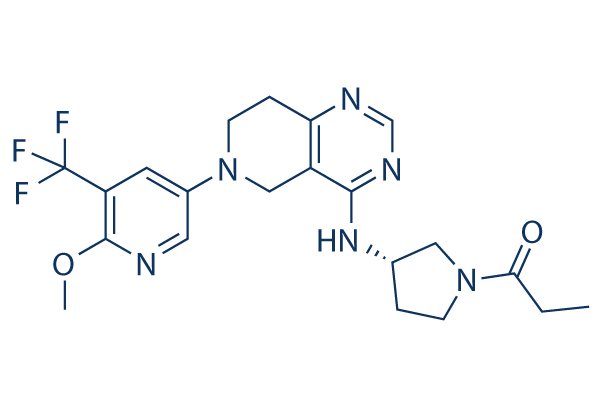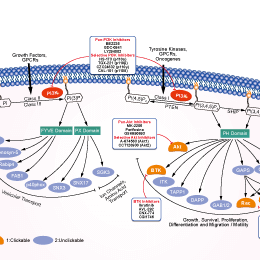
- Bioactive Compounds
- By Signaling Pathways
- PI3K/Akt/mTOR
- Epigenetics
- Methylation
- Immunology & Inflammation
- Protein Tyrosine Kinase
- Angiogenesis
- Apoptosis
- Autophagy
- ER stress & UPR
- JAK/STAT
- MAPK
- Cytoskeletal Signaling
- Cell Cycle
- TGF-beta/Smad
- DNA Damage/DNA Repair
- Compound Libraries
- Popular Compound Libraries
- Customize Library
- Clinical and FDA-approved Related
- Bioactive Compound Libraries
- Inhibitor Related
- Natural Product Related
- Metabolism Related
- Cell Death Related
- By Signaling Pathway
- By Disease
- Anti-infection and Antiviral Related
- Neuronal and Immunology Related
- Fragment and Covalent Related
- FDA-approved Drug Library
- FDA-approved & Passed Phase I Drug Library
- Preclinical/Clinical Compound Library
- Bioactive Compound Library-I
- Bioactive Compound Library-Ⅱ
- Kinase Inhibitor Library
- Express-Pick Library
- Natural Product Library
- Human Endogenous Metabolite Compound Library
- Alkaloid Compound LibraryNew
- Angiogenesis Related compound Library
- Anti-Aging Compound Library
- Anti-alzheimer Disease Compound Library
- Antibiotics compound Library
- Anti-cancer Compound Library
- Anti-cancer Compound Library-Ⅱ
- Anti-cancer Metabolism Compound Library
- Anti-Cardiovascular Disease Compound Library
- Anti-diabetic Compound Library
- Anti-infection Compound Library
- Antioxidant Compound Library
- Anti-parasitic Compound Library
- Antiviral Compound Library
- Apoptosis Compound Library
- Autophagy Compound Library
- Calcium Channel Blocker LibraryNew
- Cambridge Cancer Compound Library
- Carbohydrate Metabolism Compound LibraryNew
- Cell Cycle compound library
- CNS-Penetrant Compound Library
- Covalent Inhibitor Library
- Cytokine Inhibitor LibraryNew
- Cytoskeletal Signaling Pathway Compound Library
- DNA Damage/DNA Repair compound Library
- Drug-like Compound Library
- Endoplasmic Reticulum Stress Compound Library
- Epigenetics Compound Library
- Exosome Secretion Related Compound LibraryNew
- FDA-approved Anticancer Drug LibraryNew
- Ferroptosis Compound Library
- Flavonoid Compound Library
- Fragment Library
- Glutamine Metabolism Compound Library
- Glycolysis Compound Library
- GPCR Compound Library
- Gut Microbial Metabolite Library
- HIF-1 Signaling Pathway Compound Library
- Highly Selective Inhibitor Library
- Histone modification compound library
- HTS Library for Drug Discovery
- Human Hormone Related Compound LibraryNew
- Human Transcription Factor Compound LibraryNew
- Immunology/Inflammation Compound Library
- Inhibitor Library
- Ion Channel Ligand Library
- JAK/STAT compound library
- Lipid Metabolism Compound LibraryNew
- Macrocyclic Compound Library
- MAPK Inhibitor Library
- Medicine Food Homology Compound Library
- Metabolism Compound Library
- Methylation Compound Library
- Mouse Metabolite Compound LibraryNew
- Natural Organic Compound Library
- Neuronal Signaling Compound Library
- NF-κB Signaling Compound Library
- Nucleoside Analogue Library
- Obesity Compound Library
- Oxidative Stress Compound LibraryNew
- Plant Extract Library
- Phenotypic Screening Library
- PI3K/Akt Inhibitor Library
- Protease Inhibitor Library
- Protein-protein Interaction Inhibitor Library
- Pyroptosis Compound Library
- Small Molecule Immuno-Oncology Compound Library
- Mitochondria-Targeted Compound LibraryNew
- Stem Cell Differentiation Compound LibraryNew
- Stem Cell Signaling Compound Library
- Natural Phenol Compound LibraryNew
- Natural Terpenoid Compound LibraryNew
- TGF-beta/Smad compound library
- Traditional Chinese Medicine Library
- Tyrosine Kinase Inhibitor Library
- Ubiquitination Compound Library
-
Cherry Picking
You can personalize your library with chemicals from within Selleck's inventory. Build the right library for your research endeavors by choosing from compounds in all of our available libraries.
Please contact us at [email protected] to customize your library.
You could select:
- Antibodies
- Bioreagents
- qPCR
- 2x SYBR Green qPCR Master Mix
- 2x SYBR Green qPCR Master Mix(Low ROX)
- 2x SYBR Green qPCR Master Mix(High ROX)
- Protein Assay
- Protein A/G Magnetic Beads for IP
- Anti-Flag magnetic beads
- Anti-Flag Affinity Gel
- Anti-Myc magnetic beads
- Anti-HA magnetic beads
- Magnetic Separator
- Poly DYKDDDDK Tag Peptide lyophilized powder
- Protease Inhibitor Cocktail
- Protease Inhibitor Cocktail (EDTA-Free, 100X in DMSO)
- Phosphatase Inhibitor Cocktail (2 Tubes, 100X)
- Cell Biology
- Cell Counting Kit-8 (CCK-8)
- Animal Experiment
- Mouse Direct PCR Kit (For Genotyping)
- New Products
- Contact Us
leniolisib (CDZ 173)
Leniolisib (CDZ 173) is a potent PI3Kδ selective inhibitor with biochemical IC50 values of 0.244, 0.424, 2.23 and 0.011 μM for PI3Kα, PI3Kβ, PI3Kγ and PI3Kδ, respectively.

leniolisib (CDZ 173) Chemical Structure
CAS No. 1354690-24-6
Purity & Quality Control
Batch:
S875201
DMSO]90 mg/mL]false]Ethanol]13 mg/mL]false]Water]Insoluble]false
Purity:
99.47%
99.47
leniolisib (CDZ 173) Related Products
Signaling Pathway
Biological Activity
| Description | Leniolisib (CDZ 173) is a potent PI3Kδ selective inhibitor with biochemical IC50 values of 0.244, 0.424, 2.23 and 0.011 μM for PI3Kα, PI3Kβ, PI3Kγ and PI3Kδ, respectively. | |||||||||||
|---|---|---|---|---|---|---|---|---|---|---|---|---|
| Targets |
|
| In vitro | ||||
| In vitro | In vitro, CDZ173 inhibits a large spectrum of immune cell functions, as demonstrated in B and T cells, neutrophils, monocytes, basophils, plasmocytoid dendritic cells, and mast cells. CDZ173 showed no activity up to the highest test concentration when tested against CYP isoform assays (3A3, 2D9, 2D6, 2C9), a panel of ion channels (including hERG) and a protease panel. In a panel of 50 safety related targets (GPCRs, ion channels, transporters), CDZ173 only showed measurable activity for hPDE4D (IC50 = 4.7 μM) and 5HT2B (IC50 = 7.7 μM)[1]. |
|||
|---|---|---|---|---|
| In Vivo | ||
| In vivo | In vivo, CDZ173 inhibits B cell activation in rats and monkeys in a concentration- and time-dependent manner. After prophylactic or therapeutic dosing, CDZ173 potently inhibited antigen-specific antibody production and reduced disease symptoms in a rat collagen-induced arthritis model. CDZ173 is absorbed very quickly across species as can be seen by an early Tmax of the oral profiles. Whereas clearance is low to moderate in rats and monkeys, it was found that clearance in dogs is very low resulting in a very high exposure in blood. Plasma protein binding in dogs is very high (>99%) and the distribution of the compound is restricted into tissue (Vss = 0.3 L/kg)[1]. |
|
|---|---|---|
| Animal Research | Animal Models | Adult male Lewis rats (LEW/Han/Hsd) |
| Dosages | 10 mg/kg | |
| Administration | p.o. | |
| NCT Number | Recruitment | Conditions | Sponsor/Collaborators | Start Date | Phases |
|---|---|---|---|---|---|
| NCT06249997 | Recruiting | APDS Gene Mutation |
Pharming Technologies B.V.|Laboratory Corporation of America|Axial Biotech Inc|CMIC Co Ltd. Japan |
August 3 2023 | Phase 3 |
| NCT05693129 | Recruiting | APDS |
Pharming Technologies B.V.|CMIC Co Ltd. Japan|Labcorp Central Laboratory|Fortrea|Aixial Group |
August 30 2023 | Phase 3 |
| NCT05438407 | Active not recruiting | APDS |
Pharming Technologies B.V.|CMIC Co Ltd. Japan|Labcorp Central Laboratory|Fortrea|Aixial Group |
February 1 2023 | Phase 3 |
| NCT02859727 | Active not recruiting | Activated PI3Kdelta Syndrome (APDS); PASLI Disease |
Pharming Technologies B.V. |
September 8 2016 | Phase 2|Phase 3 |
| NCT02435173 | Completed | Common Variable Immunodeficiency (CVID) APDS / PASLI |
Novartis Pharmaceuticals|Novartis |
August 24 2015 | Phase 2|Phase 3 |
Chemical Information & Solubility
| Molecular Weight | 450.46 | Formula | C21H25F3N6O2 |
| CAS No. | 1354690-24-6 | SDF | -- |
| Smiles | CCC(=O)N1CCC(C1)NC2=NC=NC3=C2CN(CC3)C4=CC(=C(N=C4)OC)C(F)(F)F | ||
| Storage (From the date of receipt) | 3 years -20°C powder | ||
|
In vitro |
DMSO : 90 mg/mL ( (199.79 mM) Moisture-absorbing DMSO reduces solubility. Please use fresh DMSO.) Ethanol : 13 mg/mL Water : Insoluble |
Molecular Weight Calculator |
|
In vivo Add solvents to the product individually and in order. |
In vivo Formulation Calculator |
||||
Preparing Stock Solutions
Molarity Calculator
In vivo Formulation Calculator (Clear solution)
Step 1: Enter information below (Recommended: An additional animal making an allowance for loss during the experiment)
mg/kg
g
μL
Step 2: Enter the in vivo formulation (This is only the calculator, not formulation. Please contact us first if there is no in vivo formulation at the solubility Section.)
% DMSO
%
% Tween 80
% ddH2O
%DMSO
%
Calculation results:
Working concentration: mg/ml;
Method for preparing DMSO master liquid: mg drug pre-dissolved in μL DMSO ( Master liquid concentration mg/mL, Please contact us first if the concentration exceeds the DMSO solubility of the batch of drug. )
Method for preparing in vivo formulation: Take μL DMSO master liquid, next addμL PEG300, mix and clarify, next addμL Tween 80, mix and clarify, next add μL ddH2O, mix and clarify.
Method for preparing in vivo formulation: Take μL DMSO master liquid, next add μL Corn oil, mix and clarify.
Note: 1. Please make sure the liquid is clear before adding the next solvent.
2. Be sure to add the solvent(s) in order. You must ensure that the solution obtained, in the previous addition, is a clear solution before proceeding to add the next solvent. Physical methods such
as vortex, ultrasound or hot water bath can be used to aid dissolving.
Tech Support
Answers to questions you may have can be found in the inhibitor handling instructions. Topics include how to prepare stock solutions, how to store inhibitors, and issues that need special attention for cell-based assays and animal experiments.
Tel: +1-832-582-8158 Ext:3
If you have any other enquiries, please leave a message.
* Indicates a Required Field
Tags: buy leniolisib (CDZ 173) | leniolisib (CDZ 173) supplier | purchase leniolisib (CDZ 173) | leniolisib (CDZ 173) cost | leniolisib (CDZ 173) manufacturer | order leniolisib (CDZ 173) | leniolisib (CDZ 173) distributor







































